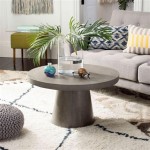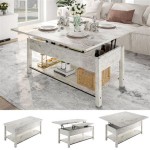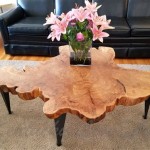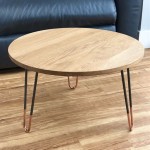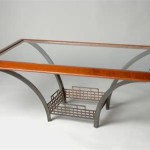Determining Optimal Coffee Table Length and Width
The coffee table, a ubiquitous piece of furniture in living rooms, serves various functions, from providing a surface for beverages and books to acting as a visual anchor for the seating arrangement. Selecting the appropriate coffee table size, specifically its length and width, is crucial for both functionality and aesthetics. An improperly sized coffee table can hinder movement, make the space feel cramped, or appear disproportionate to the surrounding furniture. Therefore, careful consideration of several factors is necessary to determine the optimal dimensions.
The process of selecting the correct coffee table length and width is not a matter of arbitrary choice. It involves a thoughtful assessment of the room's dimensions, the size and configuration of the seating arrangement, and the intended use of the table. This analysis ensures that the coffee table complements the space and enhances its overall usability.
Ignoring these considerations can lead to various problems. A coffee table that is too large can obstruct pathways and make the room feel cluttered. Conversely, a coffee table that is too small may appear insignificant and fail to adequately serve its intended purpose. The goal is to find a balance that maximizes functionality without compromising the room's visual appeal and flow.
Key Point 1: Proportionality to the Sofa
The most critical factor in determining the appropriate coffee table length is its relationship to the sofa. As a general guideline, the coffee table should be approximately two-thirds the length of the sofa. This proportion creates a harmonious visual balance and ensures that the table is accessible from all seating positions.
For instance, if a sofa is 90 inches long, the ideal coffee table length would be around 60 inches. This measurement allows for comfortable reach and prevents the table from overwhelming the sofa. Deviations from this guideline may be necessary based on the specific room layout and personal preferences, but it serves as a solid starting point.
In situations where the sofa is unusually long or short, adjustments to this two-thirds rule may be required. For very long sofas, a slightly shorter coffee table may be preferable to avoid creating an excessively long and narrow centerpiece. Conversely, for smaller sofas, a slightly larger coffee table might be necessary to provide adequate surface area.
Furthermore, the height of the sofa relative to the floor also influences the perceived size of the coffee table. A sofa with a lower profile may visually accommodate a slightly larger coffee table without appearing disproportionate, while a higher sofa might require a smaller table to maintain balance.
Consideration should also be given to the style of the sofa. A more ornate or heavily detailed sofa may benefit from a simpler coffee table design, while a minimalist sofa might be complemented by a more visually striking table. The key is to ensure that the coffee table and sofa work together to create a cohesive and aesthetically pleasing arrangement.
The proximity of other furniture pieces to the sofa also impacts the ideal coffee table length. If there are side tables or armchairs positioned close to the sofa, the coffee table length may need to be adjusted to avoid overcrowding the space. Balancing the size of the coffee table with the surrounding furniture is essential for maintaining a sense of spaciousness and order.
Key Point 2: Maintaining Adequate Walkways
The width of the coffee table is closely related to the need for adequate walkways within the living room. Clear pathways are essential for comfortable movement and preventing obstructions. The standard recommendation is to allow at least 18 inches of space between the coffee table and the sofa, as well as between the coffee table and any other furniture or walls.
This 18-inch minimum walkway ensures that individuals can easily navigate the room without bumping into the coffee table. In smaller spaces, slightly less space may be acceptable, but compromising on walkway clearance can lead to a cramped and uncomfortable environment. Ideally, the walkway should be closer to 24 inches to ensure comfortable passing, especially in high-traffic areas.
The shape of the coffee table also influences the perceived space and ease of movement. Round or oval coffee tables can be beneficial in smaller rooms, as they eliminate sharp corners and allow for more fluid movement around the table. Rectangular or square coffee tables tend to occupy more visual space and may require more deliberate placement to avoid obstructing walkways.
In open-plan living spaces, the coffee table can serve as a subtle divider between different zones, such as the seating area and the dining area. In these cases, the coffee table's width may be adjusted to help define these zones while still maintaining adequate walkways. Strategic placement of the coffee table can help to visually separate the spaces without creating a physical barrier.
The presence of other furniture pieces, such as chairs or ottomans, can restrict walkways. In such instances, the coffee table's width should be carefully considered to ensure that the available space is maximized. Prioritizing the functionality of the walkways is essential for creating a comfortable and inviting living space.
Consider the typical traffic flow in the living room to identify the areas where clear walkways are most important. Adjust the coffee table's position and size to optimize the flow of movement and prevent any obstructions in these high-traffic areas. A well-planned layout will significantly enhance the usability and comfort of the living room.
Key Point 3: Considering Room Size and Shape
The overall size and shape of the living room play a significant role in determining the appropriate coffee table dimensions. A small living room requires a smaller coffee table to avoid overwhelming the space, while a larger living room can accommodate a larger table that serves as a focal point.
In small living rooms, opting for a narrow coffee table or even a pair of smaller side tables can be a more space-efficient solution. These smaller tables provide surface area without encroaching on the available walkways. Consider using nesting tables or ottomans that can be easily moved or stored when not in use, offering flexibility and maximizing space.
In larger living rooms, a grander coffee table can be used to anchor the seating arrangement and provide ample surface area for various activities. However, care should be taken to avoid selecting a table that is disproportionately large, as this can disrupt the room's balance and create a cluttered appearance. The coffee table should complement the scale of the space and the surrounding furniture.
The shape of the living room also influences the ideal coffee table shape. In long and narrow rooms, a rectangular coffee table that mirrors the room's proportions can help to create a sense of balance. In square or more symmetrical rooms, a round or square coffee table can serve as a unifying element.
Consider the presence of architectural features, such as fireplaces or large windows, when determining the coffee table's placement and size. The coffee table should not obstruct the view of these features but should instead complement them, creating a harmonious and visually appealing arrangement. It is essential to maintain a balance between the furniture and the architectural elements of the room.
Take into account the overall style and décor of the living room when selecting the coffee table. A modern or minimalist living room may benefit from a sleek and understated coffee table, while a more traditional or eclectic living room may accommodate a more ornate or decorative table. The coffee table should seamlessly integrate with the room's overall aesthetic.
The ceiling height of the room also contributes to the perceived size and scale of the furniture. In rooms with lower ceilings, a lower-profile coffee table may be preferable to avoid creating a sense of compression. Conversely, in rooms with higher ceilings, a taller coffee table may be more visually appropriate.
Finally, consider the intended use of the coffee table. If the table is primarily intended for decorative purposes, its size and shape can be more flexible. However, if the table will be used for eating, working, or playing games, its dimensions should be optimized for functionality and accessibility.

Coffee Table Dimensions Size Guide Measurements

Coffee Table Dimension Guide Ashley Home

How To Buy A Coffee Table Living Spaces

Coffee Table Dimensions How To Choose The Right Size Tidbits Twine

The Ultimate Coffee Table Size Guide Apt2b

How To Choose The Right Size Shape Coffee Table For Your Living Space

How To Buy A Coffee Table Living Spaces

Coffee Table Dimensions How To Choose The Right Size Tidbits Twine

Nill Zanus Coffee Table Walnut Furniture

Brown Sheesham Wood Rectangle Center Coffee Table Size 2x2 92 Feet
